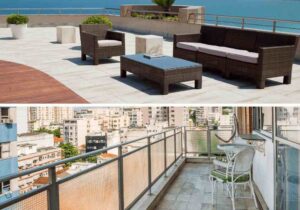Exploring the Pros and Cons of Granite and Concrete
A Comprehensive Look at Granite and Concrete
Granite and concrete stand as stalwarts in the realm of construction and design. While each material boasts unique characteristics, their applications, benefits, and limitations vary. Delving into the nuances of granite and concrete offers invaluable insights for discerning consumers.
Introduction to Granite and Concrete
What are Granite and Concrete?
Granite, a natural stone, emerges from the Earth’s crust, renowned for its durability and aesthetic allure. Conversely, concrete, a man-made amalgamation of cement, aggregates, and water, offers versatility in design and functionality.
Historical Use and Importance
Throughout history, civilizations revered granite for its robustness and elegance, adorning monuments and structures. Concrete, on the other hand, revolutionized modern architecture, facilitating innovative designs and structural integrity.
Durability: Granite vs. Concrete
Longevity and Wear Resistance
Granite epitomizes durability, withstanding the test of time and environmental factors. Concrete, albeit resilient, may require reinforcement to match granite’s enduring nature.
Maintenance and Care
Granite necessitates minimal maintenance, whereas concrete demands periodic sealing and upkeep to preserve its integrity.
Aesthetic Appeal: Exploring the Pros and Cons of Granite and Concrete
Natural Beauty of Granite
Granite exudes natural elegance, showcasing intricate patterns and hues that captivate admirers. In contrast, concrete’s aesthetic relies on design techniques and finishes to achieve desired looks.
Versatility of Concrete
Concrete’s adaptability allows for diverse finishes, textures, and designs, catering to contemporary and traditional preferences alike.
Cost Factors: An Economic Perspective
Initial Installation Costs
Granite often incurs higher initial costs due to its premium quality and installation intricacies. Conversely, concrete offers cost-effective solutions, accommodating various budget constraints.
Long-term Financial Implications
While granite may entail higher upfront expenses, its longevity and minimal maintenance offset long-term costs, making it a worthwhile investment.
Environmental Impact: Sustainability Factors
Granite’s Environmental Footprint
Granite extraction and processing may pose environmental concerns, including resource depletion and habitat disruption. In contrast, concrete production contributes to carbon emissions, warranting sustainable practices.
Concrete’s Carbon Footprint
Concrete’s carbon-intensive production necessitates eco-friendly initiatives to mitigate environmental impact, emphasizing responsible sourcing and recycling.
Application and Usage: Practical Insights
Ideal Uses for Granite
Granite excels in countertops, flooring, and architectural elements, offering unmatched elegance and durability. Conversely, concrete thrives in structural applications, paving, and decorative finishes, showcasing versatility.
Customization and Design: Flexibility Considerations
Design Variability in Granite
Granite’s natural variations and patterns enable unique design opportunities, enhancing aesthetic appeal and individuality. In contrast, concrete’s moldability and finish options allow for customized solutions, reflecting personal preferences.
Maintenance Requirements: Ease and Challenges
Cleaning Granite Surfaces
Granite’s non-porous surface simplifies cleaning, requiring routine care to maintain its luster and integrity. Conversely, concrete’s porous nature necessitates sealing and cleaning measures to prevent staining and deterioration.
Safety Considerations: Exploring the Pros and Cons
Slip Resistance and Granite
Granite’s textured surface enhances slip resistance, ensuring safety in high-traffic areas and wet conditions. However, concrete’s smooth finishes may require additional treatments to mitigate slip hazards.
Structural Integrity of Concrete
Concrete’s structural stability and load-bearing capabilities make it a preferred choice for building foundations and infrastructure, highlighting its inherent strength.
Heat and Moisture Resistance: Practical Insights
Granite’s Performance in Heat and Moisture
Granite’s natural composition provides heat and moisture resistance, making it ideal for kitchens, bathrooms, and outdoor applications. Conversely, concrete’s susceptibility to temperature fluctuations and moisture necessitates protective measures and treatments.
Popularity and Trending: Market Observations
Granite’s Timeless Appeal
Granite’s enduring popularity stems from its timeless elegance and durability, resonating with homeowners and designers seeking premium materials. Conversely, concrete’s modern resurgence reflects contemporary design trends and sustainable practices.
Expert Opinions: Insights from Professionals
Testimonials on Granite
Industry professionals laud granite for its unmatched durability, aesthetic appeal, and investment value, emphasizing its timeless allure and performance. Conversely, concrete’s versatility and innovative applications garner praise for its design flexibility and structural capabilities.
Conclusion: Final Thoughts and Recommendations
Exploring the pros and cons of granite and concrete reveals distinct advantages and limitations, guiding consumers in making informed decisions based on specific needs, preferences, and budget constraints. While granite captivates with its natural beauty and durability, concrete offers versatility and design flexibility, catering to diverse applications and aesthetic preferences.
FAQs: Common Queries Answered
How does granite compare to concrete in terms of maintenance?
Granite requires minimal maintenance, while concrete demands periodic sealing and upkeep to preserve its appearance and integrity.
Which material is more environmentally friendly?
Both materials pose environmental concerns; however, sustainable practices in extraction, production, and disposal mitigate adverse impacts.
Are there any safety concerns associated with granite or concrete?
Granite’s textured surface enhances slip resistance, whereas concrete may require treatments to mitigate slip hazards.
How do the costs of granite and concrete differ over time?
Granite may entail higher initial costs; however, its longevity and minimal maintenance offset long-term expenses compared to concrete.
What are the design limitations of both materials?
Granite’s natural variations may limit design consistency, while concrete’s moldability allows for diverse finishes and textures.
Which material is better suited for outdoor applications?
Granite’s natural composition provides heat and moisture resistance, making it ideal for outdoor applications compared to concrete.














